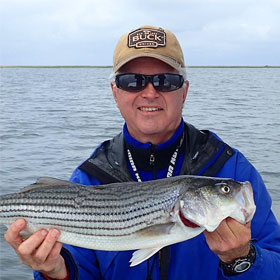What to Know When Choosing Ice Fishing Lines
By Ken Schultz
Jan 21, 2022
What to consider when choosing ice fishing lines and leaders, based on critical line characteristics, whether jigging or using tip ups, and the depth to be fished
Ice fishing is accomplished by vertically fishing either with a short rod and reel that is manually manipulated, generally by jigging a lure, or by using a tip up that has only a reel and which (more or less) passively fishes some form of bait. Line is necessary for both reels, of course, but which ice fishing lines to use varies just as it does in open water fishing.
Lines for Tip Up Fishing
When a fish takes a bait set under a tip up, you have to remove the tip up from the ice hole and bring the line (and fish) in hand over hand. This is easier done with a large-diameter nylon monofilament line, or with a braided Dacron line, than with a braided superline, which has a small diameter and is much more expensive. Depending on the product and what you’re fishing for, 17- to 40-pound-test nylon and Dacron ice fishing lines fill the bill. A leader might be attached to the monofilament, but should definitely be used with the Dacron. Mono will probably be more abrasion resistant (think ice fragments around the hole), than an uncoated Dacron line, but there are products coated to resist freezeup and abrasion.
Lines for Rod-and-Reel Jigging
Some ice anglers prefer nylon monofilament ice fishing lines because of ease in knot tying, good abrasion resistance, the existence of stretch to counter the surges of larger fish, a more-forgiving nature, and generally low cost. However, monofilaments retain memory and become coiled, especially in cold water, reducing sensitivity. And, since nylon absorbs water, it can lead to ice buildup on the reel and on rod guides. A coated nylon monofilament that resists water absorption would be a good alternative to a line that you might use in open-water fishing.
Braided superlines (microfilament lines) have devotees for ice fishing as well, because their low stretch increases sensitivity and strike detection, which is a benefit when jigging, and their thin diameter enhances sink rate, which is especially beneficial when fishing in deep water. Water pickup and ice buildup can be a problem, however, so a coated superline specifically meant for ice fishing is a better alternative to one meant for open-water fishing. Also, you need to attach a leader to the end of the braided line.
Leader Line
This boils down to monofilament, fluorocarbon, or blended/hybrid line. Fluorocarbon is favored by many ice anglers because of its lower visibility and the fact that a lot of ice fishing is done in clear water. It’s questionable, however, that this makes a difference the deeper you fish. Fluorocarbon sinks quickly, has good abrasion resistance, and has low stretch but is prone to stiffness and memory, and is more expensive than nylon monofilament. A good compromise might be a blended (copolymer) line or a line that is part-fluorocarbon part-nylon (hybrid), which have good strength and less stretch than nylon mono, and are less expensive as well.
Remember that when you’re thinking about the best ice fishing lines, a lot depends on what you’re fishing for, how deep you’re fishing, and the size of the lures and bait you’ll be using.









